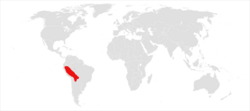Biology:Bolivian squirrel
| Bolivian squirrel | |
|---|---|

| |
| Scientific classification | |
| Domain: | Eukaryota |
| Kingdom: | Animalia |
| Phylum: | Chordata |
| Class: | Mammalia |
| Order: | Rodentia |
| Family: | Sciuridae |
| Genus: | Sciurus |
| Species: | S. ignitus
|
| Binomial name | |
| Sciurus ignitus (Gray, 1867)
| |
| Subspecies[2] | |
|
See text | |

| |
| Bolivian squirrel's range | |
The Bolivian squirrel (Sciurus ignitus) is a tree squirrel that is endemic to South America. Little is known of the species, which may represent a species complex.[1]
Description
Bolivian squirrels are moderately sized tree squirrels, with a head-body length of 14 to 22 cm (5.5 to 8.7 in), and a tail of similar length again. Adults weigh from 183 to 242 g (6.5 to 8.5 oz). The fur is mostly dark olive with black and yellow ticking and fading to pale grey or whitish on the chest and underparts. There are faint rings of buff-coloured fur around the eyes and distinct patches of buff fur on the backs of the ears. Females have three pairs of teats.[3]
Distribution and habitat
Bolivian squirrels live along the eastern edge of the Andes from Peru, through Bolivia and Brazil to extreme northern Argentina . Precise details of its habitat are not clear, although it has been found in both lowland and montane tropical forests from 200 to 2,700 m (660 to 8,860 ft) elevation.[3]
Five subspecies are recognised:
- S. i. ignitus - northern Bolivia
- S. i. argentinius - Argentina
- S. i. boliviensis - central and southern Bolivia
- S. i. cabrerai - known from a single partial specimen from Brazil
- S. i. irroratus - Peru, western Brazil
Behaviour and biology
Bolivian squirrels are diurnal and spend the day moving through the understory and subcanopy of the forest. They are omnivorous, feeding on a mixture of nuts, fruits, fungi, and insects. They are generally solitary, and construct round nests from leaves and twigs, hidden among foliage and vines about 6 to 10 m (20 to 33 ft) above the ground. Juveniles have been captured in June and July, and pregnant mothers in August, which may suggest that they breed during the dry season.[3]
References
- ↑ 1.0 1.1 Koprowski, J.; Roach, N. (2019). "Sciurus ignitus". IUCN Red List of Threatened Species 2019: e.T20012A22247828. doi:10.2305/IUCN.UK.2019-1.RLTS.T20012A22247828.en. https://www.iucnredlist.org/species/20012/22247828. Retrieved 19 November 2021.
- ↑ Thorington, R.W. Jr.; Hoffmann, R.S. (2005). "Sciurus (Guerlinguetus) ignitus". in Wilson, D.E.; Reeder, D.M. Mammal Species of the World: a taxonomic and geographic reference (3rd ed.). The Johns Hopkins University Press. pp. 754–818. ISBN 0-8018-8221-4. OCLC 26158608. https://www.departments.bucknell.edu/biology/resources/msw3/browse.asp?id=12400162.
- ↑ 3.0 3.1 3.2 Merrick, M.J.; Ketcham, S.L.; Koprowski, J.L. (December 2014). "Sciurus ignitus (Rodentia: Sciuridae)". Mammalian Species (915): 93–100. doi:10.1644/915.1.
4. Timm, R. M., J. L. Cartes, M. Ruiz-Díaz, R. Zárate, and R. H. Pine. (2015). Distribution and ecology of squirrels (Rodentia: Sciuridae) in Paraguay, with first country records for Sciurus ignitus. Southwestern Naturalist 60(1):121–127.
Wikidata ☰ Q1762496 entry
 |


